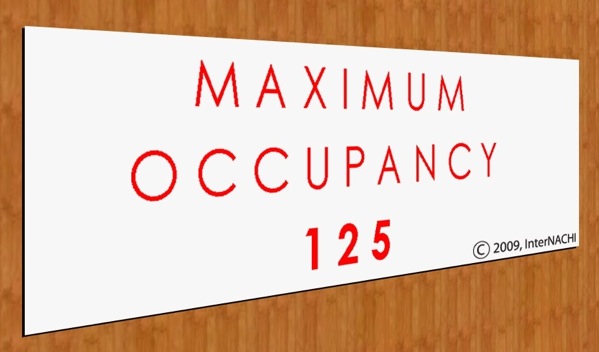

Occupancy load refers to the number of people permitted in a building at one time based on the building’s floor space and function. The occupancy load must be posted on signs, which are sometimes called maximum occupancy signs, so that this information is publicly available. To exceed occupancy load or fail to post occupancy load signs in the required places can result in fines and is a serious safety hazard.
Emergencies can require the immediate evacuation of a building, particularly in the event of a fire. Any delay in evacuation can be tragic, as was the case in the 2003 Station Night Club fire in West Warwick, Rhode Island, which killed 100 people in just over five minutes. The fire was so lethal because evacuation was sluggish, partly due to the fact that the actual number of people present was much higher than the building’s occupancy load.
Sign Inspection InterNACHI inspectors can consider the following questions while they inspect load occupancy signs:Signs shall [have a] minimum of 1-inch block letters and numbers on a contrasting background so as to be readily visible. Allowable smaller lettering shall be a minimum of 3/8- inch block lettering.
Every room or space that is an assembly occupancy shall have the occupant load of the room or space posted in a conspicuous place, near the main exit or exit access doorway from the room or space.
Additional recommendations can be drawn from the Houston Fire Code, which requires that occupancy load signs be placed in the following manner:
The sign shall be located in a conspicuous location within the room, adjacent to the main exit, so as to not be obstructed by doors, curtains, poster board stands, furniture, room dividers, or similar items. The sign shall be posted not more than 60 inches nor less than 48 inches above the floor.
Occupancy load is calculated by dividing the area of a room by its prescribed unit of area per person. Units of area per person for specific buildings can be found in the chart at the end of this article. For instance, the chart dictates that dormitories require 50 square feet of floor area for every room occupant. Consequently, a dorm room that has 100 square feet of floor space will have a maximum occupancy of two people. The amount of space required per person varies based on the function of the room, which is determined by the building’s designer.
In summary, occupancy load must be posted in many buildings on signs that are clearly visible and legible.